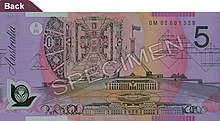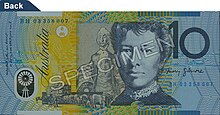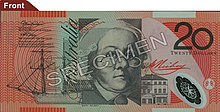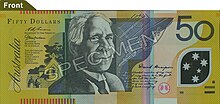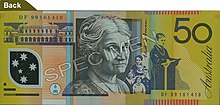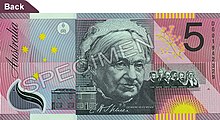Australian dollar
| Australian dollar | |
|---|---|
| Country: |
|
| Subdivision: | 100 cents |
| ISO 4217 code : | AUD |
| Abbreviation: | $ A, A $, AU $ |
|
Exchange rate : (August 24, 2020) |
1 EUR = 1.6454 AUD 1 CHF = 1.529 AUD |
The Australian dollar is the currency of Australia issued by the Reserve Bank of Australia (RBA). It is also used as the official currency in Kiribati , Nauru and Tuvalu . The Australian dollar ranks 6th among the most traded currencies worldwide, behind the US dollar , the euro , the yen , the pound sterling and the Swiss franc .
The Australian dollar is divided into 100 cents . The 5, 10, 20, 50 and 100 dollar banknotes are printed by the Australian banknote printer, Note Printing Australia . There are coins of 5, 10, 20 and 50 cents, as well as 1 and 2 dollars. These are mainly produced by the Royal Australian Mint . The minting of 1 and 2 cent coins was discontinued in 1992.
The common abbreviation in Australia is the dollar sign ($); sometimes A $ or AU $ is used to distinguish it from other dollar currencies . The nickname is "Aussie".
history
In 1910 the Australian pound was introduced as a separate currency for Australia, which was retained until 1966. Like the British pound, it was divided into 20 shillings to 12 pence .
Bretton Woods
From July 1 to July 22, 1944, representatives from 44 states gathered in Bretton Woods, New Hampshire, to discuss the reorganization of the world economy, which had been weakened by World War II . Important currency, trade and payment issues should be raised for discussion. As a result of the meeting, the International Monetary Fund was established, which Australia joined in 1947. The US dollar has been set as the international reserve, reserve and transaction currency. It thus became the base unit for converting to gold (35 USD / ounce). Fixed exchange rates for other currencies were also set. The Australian dollar was also pegged to the US dollar when it was introduced in February 1966. From the mid-1960s onwards, the Bretton Woods system showed increasing weaknesses. Due to the differently fast growing economies, a respective adjustment of the exchange rates, deviating from the Bretton Woods system, was inevitable.
Introduction of the decimal currency system
In international comparison, the English system of coins on which the Australian was based was considered outdated and complicated, and Australia was one of the last countries to use it. Therefore a long-term conversion was planned.
In 1963 the Australian government decided to replace this system with a decimal system and to issue a new series of banknotes. The decimal system is characterized by the fact that the main currency unit is divided into powers of ten. The smallest sub-unit is usually a hundredth of the main currency unit. In the decimal system of the Australian dollar, 1 AUD forms the basis and is divided into 100 cents.
An important change in the course of the change in the currency system concerned the name of the new currency unit. In order to find a suitable name for the new currency, the Australian government launched a call to solicit suggestions for names. The suggested names varied from traditional names such as “Pound” and “Dollar” to specifically Australian names such as “Austral”. Very exotic creations such as “Boomer”, “Oz”, “Kanga” or “Emu” were also mentioned. Since no agreement could be reached, the government decided in June 1963 to name the new currency "Royal", as this would emphasize the connection to the kroon and a name worthy of the Australian currency.
On September 19, 1963, however, the government announced that the name of the future currency unit was "dollar" because it could not withstand the strong opposition to the name "royal". This decision met with general approval. Before the introduction of the decimal currency, however, a targeted program was necessary to inform the public and familiarize them with the new counting method. This included extensive media coverage, playful learning with the help of play money in schools, and detailed brochures that explained the changeover and outlined the effects on the prices of goods. One campaign to explain the new system was the Dollar Bill campaign, which was launched in 1965. The new decimal currency was introduced as February 14, 1966, and according to this plan, the currency was decimalized on February 14, 1966. One pound was converted into two dollars.
In 1971, Australia decided to break its established relationship with the US dollar and step out of the fixed exchange rate system. Other countries left the fixed exchange rate system, leading to the final collapse of the Bretton Woods system in 1973. Other monetary systems were introduced at the direction of the government, but none of them proved competitive in the international market. During the 1970s, Australia's economic performance deteriorated immensely and there was hardly any economic growth left. Inflation and unemployment rose. In 1976 the AUD was devalued by 17.6 percent.
The trade weighted index (TWI) was introduced. This index represents a basket of currencies. The currencies are weighted differently. The share of national currencies is determined by the importance the country has for Australia's import and export business. The TWI provides information about the international competitiveness of Australia.
Control of the financial system
According to the Reserve Bank Act 1959, the Reserve Bank of Australia (RBA), the central bank of Australia, was given responsibility for regulating the circulation of banknotes, more precisely for the production, issuance, reissue and redemption of Australian banknotes and currency control. However, until the 1970s, the Australian dollar was largely under government control, as was the entire Australian financial market. The aim of these controls was to create a market that would allow the government to support and finance itself. Furthermore, any risks associated with banking should be avoided through government surveillance. Stable exchange rates should be achieved. All savings should be invested domestically. Loans were specifically issued. Construction projects of private households and agriculture were favored for this. Control measures were for example:
- Control and set the interest rate on loans and deposits
- Control of economic indicators, such as B. Liquidity , as well as the balance sheets
- Monitoring the amount and the occasion of lending
- Banks were given precise guidelines on their scope of action.
Abolition of controls
From the beginning of the 1970s to the mid-1980s, controls were gradually abolished and the financial market relaxed. International capital flows soared after the collapse of the Bretton Woods system, which put pressure on the Australian exchange rate. The government was only able to stabilize the exchange rate by intervening in the foreign exchange market, which, however, severely restricted domestic liquidity as large sums of money had to be raised. The easing process began in 1973 with the removal of interest rate controls. That was the first small step towards a free financial market. In the years that followed, the Australian market was opened to foreign banks. The establishment of domestic banks has also been made easier. In December 1983 a flexible currency system was introduced and the Australian dollar was first traded on the foreign exchange market. Since then, the exchange rate has been determined by supply and demand on the foreign exchange market. Since the AUD went public, the RBA has nevertheless actively intervened in the foreign exchange market.
Development of the Australian dollar until today
In the 1990s, the Australian financial market developed rapidly and Australia's economy was gradually integrated into the world economy. The Australian dollar became increasingly important. In 1997 the Asian crisis began in Thailand, Korea and Indonesia before a financial crisis hit Russia and Latin America. For Australia this meant slumps in the export market, which led to strong fluctuations in the Australian dollar. This tried to contain the RBA and made many transactions on the foreign exchange market to stabilize the exchange rate. The central bank's interventions included buying or selling the US dollar according to the situation. During the Russian crisis, call options were issued on the Australian dollar, with which one could acquire it at a previously determined exchange rate. In 2008, the global financial crisis also had an impact on the value and development of the Australian dollar. Overall, the RBA only intervenes on an average of 5% of all trading days today.
Australian dollar spending
Issue of banknotes
The banknotes are issued by the Reserve Bank of Australia.
The first paper editions of the Australian dollar in the face value of the 1, 2, 10 and 20 AUD notes were the exact equivalents of the previous pound notes. The AUD 5 note was not issued until 1967, after the public got used to the decimal currency system. The AUD 50 note was introduced in 1973 and the AUD 100 note in 1984. In 1984 the 1 AUD note and in 1988 the 2 AUD note were replaced by the simultaneous introduction of the 1 and 2 AUD coins.
The RBA attaches great importance to guaranteeing the high quality of the notes in circulation. In doing so, she wants to strengthen and secure trust in the Australian currency. For this purpose, quality standards were set in the so-called “Note Sorting Guide”. From time to time the RBA will order the banknotes to be taken out of circulation. The banknotes are then checked for quality and authenticity. This enables the RBA to monitor the quality and authenticity of the banknotes in circulation and to ensure their future suitability. Real, but no longer suitable banknotes are destroyed, real suitable banknotes are reissued to the commercial banks. Counterfeit banknotes are handed over to the Australian Federal Police .
On May 9, 2019, it became known that there was a typographical error in the small print on the newly issued 50 dollar bill since October 2018: the word responsibility is consistently missing a letter "i" ( responsibilty ). The error could only be discovered with a magnifying glass and only became known after 46 million banknotes had been put into circulation. The Reserve Bank of Australia announced that the error on future banknotes will be eliminated.
Issue of coins
The Royal Australian Mint is responsible for issuing the coins. In 1966, coins with face values of 1, 2, 5, 10, 20, and 50 cents were introduced.
1 cent coin
The 1 cent coin was introduced on February 14, 1966 and has retained its design to this day. On August 21, 1990, it was announced that the issue of the 1-cent coin would be discontinued from February 1992, but that it would continue to be legal tender.
2 cent coin
The history of the 2 cent coin follows the same course as that of the 1 cent coin.
5 cent coin
The design of the 5-cent coin has also not changed since its introduction. All 5 cent coins introduced in 1966 were minted at the Royal British Mint in London.
10 cent coin
The reverse of the 10-cent coin today is identical to that of 1966. All 10-cent coins were also minted in London, and all subsequent editions in other mints.
20 cent coin
The original appearance of the 20 cent coin from 1966 remained unchanged until 1995; however, there have already been several special editions. The first coins were all minted by the Royal British Mint in London.
50 cent coin
The coin with the highest face value at the time of its introduction on February 14, 1966, the 50 cent coin, contained 80% silver. Due to the rising silver prices , the value of the coin far exceeded the actual face value and was therefore replaced in 1968 by a copper-nickel alloy. Another reason for the redesign of the coin was the strong resemblance to the 20-cent coin, which is why the new 50-cent coin was designed with twelve corners instead of the rounded 20-cent coin.
1 dollar coin
The AUD 1 coin was introduced on May 14, 1984. Planning for the AUD 1 coin began as early as the mid-1970s. Already at this point it became clear that a higher quality coin was required that could be used in coin machines. The AUD 1 note should also be replaced, as it only had a short lifespan due to the high turnover rate.
2 dollar coin
The AUD 2 coin went into circulation on June 20, 1988. Like the AUD 1 coin, the AUD 2 coin was also intended to replace the heavily used AUD 2 note.
Current Australian dollar banknotes and coins
| value | motive | size | Date of first issue | ||
|---|---|---|---|---|---|
| New series from 2016 | |||||
| 5 dollars |
|
130 mm × 65 mm | September 1, 2016 | ||
| Older banknotes | |||||
| 5 dollars |
|
130 mm × 65 mm | July 7, 1992 new coloring from April 24, 1995. |
||
| 10 dollars |
|
137 mm × 65 mm | November 1, 1993 | ||
| 20 dollars |
|
144 mm × 65 mm | October 31, 1994 | ||
| 50 dollars |
|
151 mm × 65 mm | 4th October 1995 | ||
| 100 dollars |
|
158 mm × 65 mm | May 15, 1996 | ||
| Special edition for the 100th state anniversary | |||||
| 5 dollars |
|
130 mm × 65 mm | January 1, 2001 | ||
These notes took up the themes of the previous notes, showed the social and cultural diversity of Australia and recognized scientific achievements through portraits of outstanding men and women from Australian history.
| Face value | Motif on the back | material | Weight | diameter | Date of first issue |
|---|---|---|---|---|---|
| 1 cent | Feather-tail sliding pouches | 97% Cu , 2.5% Zn , 0.5% Sn | 2.6 g | 17.65 mm | February 14, 1966 |
| 2 cents | frilled lizard | 97% Cu, 2.5% Zn, 0.5% Sn | 5.2 g | 21.59 mm | February 14, 1966 |
| 5 cents | Echidna | 75% Cu, 25% Ni | 2.83 g | 19.41 mm | February 14, 1966 |
| 10 cents | Gray-back lyre-tail | 75% Cu, 25% Ni | 5.65 g | 23.60 mm | February 14, 1966 |
| 20 cents | platypus | 75% Cu, 25% Ni | 11.3 g | 28.65 mm | February 14, 1966 |
| 50 cents | Coat of arms of australia | 75% Cu, 25% Ni | 15.55 g | 31.65 mm | September 1969 |
| 1 dollar | 5 kangaroos | 92% Cu, 6% Al , 2% Ni | 9.0 g | 25.00 mm | May 14, 1984 |
| 2 dollars | Aboriginal , Southern Cross | 92% Cu, 6% Al, 2% Ni | 6.60 g | 20.50 mm | June 20, 1988 |
All coins bear the portrait of Queen Elizabeth II on the obverse. The originally round 50 cent coin was minted in a twelve-sided shape from 1969. The 1 and 2 cent coins made from 97% copper were withdrawn from circulation in early 1992. In cash transactions, amounts are rounded to 5 cents.
Polymer banknotes
Introduction of synthetic polymer banknotes
The banknotes of Australia have been converted from a paper to a synthetic polymer substrate base (also plastic or plastic) and have been significantly redesigned. This polymer technology was developed by the Commonwealth Scientific and Industrial Research Organization (CSIRO), the government agency for scientific and industrial research. In 1985, the first synthetic polymer substrate note was brought into circulation as a sample copy. It was an AUD 10 commemorative note in honor of Australia's 200th anniversary in 1988.
First complete series of polymer notes
The polymer technology test was considered a great success. A full line of polymer banknotes from AUD 5 to AUD 100 was then produced between 1992 and 1996. The AUD 5 note was introduced in July 1992, the color of which was revised again in April 1995 in order to better distinguish it from the AUD 10 note introduced in November 1993. The AUD 20 note was put into circulation in October 1994 and the AUD 50 note in October 1995. The AUD 100 note followed in May 1996.
Reasons for the polymer substrate based banknotes
The Australian government had set itself the goal of making the Australian dollar one of the safest currencies with the most modern security features. However, there was already a scandal in the year of the launch when counterfeit AUD 10 notes came into circulation. That was the reason for a partnership between the RBA and the CSIRO to develop new technologies that should make the new currency more secure. The need to change banknotes was compounded in the 1970s and 1980s by the increasing availability of high quality photocopying technology. For the time being, the CSIRO concentrated on the development of a hologram- like, diffractively optically variable feature. Since it has a better visual effect on a smooth surface, it was decided to use this feature as the most important security element for the new banknotes.
After a few years, however, the focus shifted from diffractive optically variable elements to more favorable security measures. A see-through window, which was not possible on paper notes, was used and should prove to be cheaper and just as effective.
Benefits of polymer notes
While polymer technology for currencies was developed to make counterfeiting more difficult and more expensive, it also has advantages over paper money in terms of durability and recyclability. Polymer notes last about four times longer than paper money. The polymer substrate is tougher and more resistant to damage from moisture, dirt, oil and household chemicals. This improved durability is reflected in the reduction in the number of declining banknotes. A major environmental benefit is that polymer banknotes can be recycled, whereas waste from paper notes can only be buried or incinerated. Polymer banknotes that are no longer usable are granulated, melted and then recycled.
Export of the polymer note
At the end of 2008 there were already 25 countries from all regions of the world whose banknotes were based on Australian polymer technology. This development is in stark contrast to the situation at the end of the 19th century, when Australia had to import all of the technology and know-how of sheet music printing.
In 1990 the technology was adopted by Singapore, 1991 by Papua New Guinea, 1991 Western Samoa, 1993 by Kuwait, 1994 by Indonesia, 1996 by Brunei, 1996 by Thailand, 1998 by Malaysia, 1998 by Sri Lanka, 1999 by New Zealand, 1999 by Northern Ireland, 1999 from Romania, 1999 from Taiwan, 2000 from Bangladesh, 2000 from Brazil, 2001 from China, 2001 from Solomon Islands, 2001 from Vietnam, 2002 from Mexico, 2002 from Nepal, 2003 from Zambia, 2004 from Chile, 2007 from Guatemala, 2007 from Hong Kong, 2007 from Nigeria. and partially from Israel in 2008.
Security features
Special features are specifically incorporated into banknotes in order to be able to distinguish real banknotes from counterfeit money. With the help of a combination of several security features, counterfeiting banknotes should be made almost impossible:
- See-through window
- The transparent plastic window is incorporated into the banknote and forms a smooth surface with the banknote. The embossing of an image is printed in this window. Only the AUD 5 federation commemorative note does not contain such a coinage.
- Polymer substrate
- The banknote is printed on a special polymer (plastic). The majority of counterfeits are printed on paper, which means that you can tell a difference by touch.
- Microtext
- Micro fonts are small fonts that can be seen with a magnifying glass (e.g. FIFTY dollars).
- Steel engraving gravure
- The use of the steel engraving gravure printing process enables the printing of a relief that can be felt.
- Watermark
- If the bill is held up to the light, the Australian national coat of arms becomes visible. The seven-pointed star, which is partially attached to the front and back, is also completed.
- Fluorescent fonts
- The serial number and face value of the note will fluoresce under ultraviolet light .
- Background printing
- Various line structures and patterns as well as special colors that are printed with special ink and cannot be reproduced with conventional color printers because they are outside the normal color space characterize the background.
Exchange rates
The share of the Australian dollar in the total number of transactions in the foreign exchange market is about 6 percent. This is number 6 among the most traded currencies in the world. The value of the Australian dollar was $ 1.4875 from September 1973 to August 1974, its all-time high. In September 2001, however, the previous low was recorded at a value of 0.4923 USD.
| year | 1 A $ | year | 1 A $ | year | 1 A $ |
|---|---|---|---|---|---|
| 1970 | $ 1.1159 | 1985 | $ 0.7012 | 2000 | $ 0.5761 |
| 1975 | 1.3074 USD | 1990 | $ 0.7799 | 2005 | $ 0.7606 |
| 1980 | $ 1.1423 | 1995 | $ 0.7394 | (Jan – Oct) 2009 | $ 0.7769 |
In exchange for the euro, the Australian dollar had its highest level to date in January 2000 at a value of 0.6509 euros. In February 2009, the Australian dollar was only worth 0.5069 euros.
| year | 1 AUD |
|---|---|
| 2000 | 0.6264 EUR |
| 2005 | 0.6142 EUR |
| (Jan – Oct) 2009 | € 0.5604 |
inflation
During the 1990s, many countries with high inflation rates switched to so-called inflation targeting . Monetary policy is based directly on the development of inflation. Australia switched to this direct inflation control strategy in 1993. In this concept, the role of monetary stability as a goal of monetary policy is emphasized. The goals of monetary policy are currency stability, full employment, economic success and the well-being of the population. To achieve these goals, the RBA focuses on price stability. A limit of 3% was set, which the inflation rate should not exceed in the medium term. The current inflation rate is 1.6%.
Extended scope
In addition to the local currency, the Australian dollar is legal tender in Kiribati , Tuvalu and Nauru . In addition, the introduction of the Australian dollar as the currency unit for the Pacific islands is discussed in the literature. This has also been proposed by the International Monetary Fund . The Australian versus the New Zealand dollar is considered more suitable.
Possible abolition of the 5 cent coin
According to press reports from summer 2011, the Australian mint issued a confidential letter to the Australian government informing them that the production of the 5-cent coin, which consists of 75% copper and 25% nickel, is more expensive than face value. In addition, it is superfluous because many in Australia pay cashless. The government stated that the elimination of the coin would create problems for fundraising and retailers might use the elimination to round up prices. A decision is still pending.
literature
- Beate Varnhorn: Bertelsmann - The new universal dictionary: 70,000 headwords and explained terms: 100 tables. Wissenmedia Verlag, 2006, ISBN 3-577-10298-5
- Dennis Metz: Foreign exchange trading: Profiting from dollars, euros and Co. FinanzBook Verlag, 2004, ISBN 3-89879-065-7
- Horst Gischer, Bernhard Herz, Lukas Menkhoff: Money, Credit and Banks: An Introduction. 2nd Edition. Springer Verlag, Berlin 2005, ISBN 3-540-24169-8
- Arthur Grimes, Roger John Bowden, Sir Frank Wakefield Holmes: '' An ANZAC dollar?: Currency union and business development ''. Institute of Policy Studies, Victoria University of Wellington 2000, ISBN 0-908935-47-1
- Gordon de Brouwer: Should Pacific island countries adopt the Australian dollar? In: Pacific Economic Bulletin . vol. 15, No. 2, 2000, pp. 161-169
Web links
- The banknotes of Australia (German, English)
Individual evidence
- ↑ Beate Varnhorn: Bertelsmann - The new universal dictionary: 70,000 headwords and explained terms: 100 tables. Wissenmedia Verlag, 2006, ISBN 3-577-10298-5 , p. 486, p. 657, p. 972
- ↑ a b Encyclopedic lexicon for money, banking and stock exchange. 3rd edition, 1967, p. 116.
- ↑ a b two cents. Royal Australian Mint; Retrieved November 26, 2009.
- ↑ Dennis Metz: Foreign exchange trading: Profit from Dollar, Euro and Co. 2004, p. 33.
- ↑ Australian dollar. Day trading; accessed November 28, 2009.
- ^ Bretton Woods Conference. Worldbank; Retrieved November 27, 2009.
- ↑ World Monetary System. Federal Agency for Political Education ; Retrieved November 27, 2009
- ↑ Timeline. ( Memento of the original from February 9, 2010 in the Internet Archive ) Info: The archive link was inserted automatically and has not yet been checked. Please check the original and archive link according to the instructions and then remove this notice. Museum of Australian Currency Notes; Retrieved November 27, 2009.
- ↑ The collapse of Bretton Woods. ( Memento of the original from November 28, 2009 in the Internet Archive ) Info: The archive link was inserted automatically and has not yet been checked. Please check the original and archive link according to the instructions and then remove this notice. Turning point; Retrieved November 27, 2009.
- ^ The Royal Controversy. ( Memento of the original from October 16, 2009 in the Internet Archive ) Info: The archive link was inserted automatically and has not yet been checked. Please check the original and archive link according to the instructions and then remove this notice. Museum of Australian Currency Notes; Retrieved November 26, 2009.
- ^ Introducing the New Decimal Notes. ( Memento of the original from March 28, 2010 in the Internet Archive ) Info: The archive link was inserted automatically and has not yet been checked. Please check the original and archive link according to the instructions and then remove this notice. Museum of Australian Currency Notes; Retrieved November 26, 2009.
- ↑ Timeline. ( Memento of the original from February 9, 2010 in the Internet Archive ) Info: The archive link was inserted automatically and has not yet been checked. Please check the original and archive link according to the instructions and then remove this notice. Museum of Australian Currency Notes; Retrieved November 27, 2009.
- ↑ Breakdown of the Bretton Woods system in 1973. ( Memento of the original from November 28, 2009 in the Internet Archive ) Info: The archive link was automatically inserted and not yet checked. Please check the original and archive link according to the instructions and then remove this notice. Turning point; Retrieved December 21, 2009.
- ↑ Timeline 1991-2001. ( Memento of the original from February 9, 2010 in the Internet Archive ) Info: The archive link was inserted automatically and has not yet been checked. Please check the original and archive link according to the instructions and then remove this notice. Museum of Australian Currency Notes; Retrieved December 14, 2009.
- ↑ Trade Weighted Index. (PDF; 125 kB) Reserve Bank of Australia; Retrieved December 14, 2009.
- ↑ a b Financial Deregulation. Reserve Bank of Australia; Retrieved December 14, 2009
- ^ Foreign Exchange Intervention and the Australian Dollar: Has It Mattered? (PDF; 933 kB) IMF; Retrieved December 13, 2009.
- ^ Notes in Circulation. ( Memento of the original from October 16, 2009 in the Internet Archive ) Info: The archive link was inserted automatically and has not yet been checked. Please check the original and archive link according to the instructions and then remove this notice. Reserve Bank of Australia; Retrieved November 26, 2009.
- ^ Role of the RBA. ( Memento of the original from September 29, 2009 in the Internet Archive ) Info: The archive link was inserted automatically and has not yet been checked. Please check the original and archive link according to the instructions and then remove this notice. Reserve Bank of Australia; Retrieved November 26, 2009.
- ↑ Australia's A $ 50 note misspells responsibility. BBC News, May 9, 2019, accessed May 9, 2019 .
- ↑ one cent. Royal Australian Mint; Retrieved November 26, 2009.
- ↑ five cents. Royal Australian Mint; Retrieved November 26, 2009.
- ↑ ten cent. Royal Australian Mint; Retrieved November 26, 2009.
- ↑ twenty cent. Royal Australian Mint; Retrieved November 26, 2009.
- ↑ fifty cent. Royal Australian Mint; Retrieved November 26, 2009.
- ↑ one dollar. Royal Australian Mint; Retrieved November 26, 2009.
- ↑ two dollars. Royal Australian Mint; Retrieved November 26, 2009.
- ^ Notes in Circulation. ( Memento of the original from October 30, 2009 in the Internet Archive ) Info: The archive link was automatically inserted and not yet checked. Please check the original and archive link according to the instructions and then remove this notice. Reserve Bank of Australia; Retrieved November 26, 2009.
- ↑ Obverse. ( Memento of the original from November 23, 2009 in the Internet Archive ) Info: The archive link was inserted automatically and has not yet been checked. Please check the original and archive link according to the instructions and then remove this notice. Royal Australian Mint; Retrieved November 27, 2009.
- ↑ 1 cent. Royal Australian Mint; Retrieved November 27, 2009.
- ^ A New Era: Polymer Currency. ( Memento of the original from October 16, 2009 in the Internet Archive ) Info: The archive link was inserted automatically and has not yet been checked. Please check the original and archive link according to the instructions and then remove this notice. Museum of Australian Currency Notes; Retrieved November 26, 2009.
- ^ The First Polymer Notes. ( Memento of the original from October 16, 2009 in the Internet Archive ) Info: The archive link was inserted automatically and has not yet been checked. Please check the original and archive link according to the instructions and then remove this notice. Museum of Australian Currency Notes; Retrieved November 26, 2009.
- ↑ Timeline 1991-2001. ( Memento of the original from February 9, 2010 in the Internet Archive ) Info: The archive link was inserted automatically and has not yet been checked. Please check the original and archive link according to the instructions and then remove this notice. Museum of Australian Currency Notes; Retrieved November 26, 2009.
- ↑ Why Polymer? ( Memento of the original from October 16, 2009 in the Internet Archive ) Info: The archive link was inserted automatically and has not yet been checked. Please check the original and archive link according to the instructions and then remove this notice. Museum of Australian Currency Notes; Retrieved November 26, 2009.
- ^ Advantages of Polymer Notes. ( Memento of the original from October 16, 2009 in the Internet Archive ) Info: The archive link was inserted automatically and has not yet been checked. Please check the original and archive link according to the instructions and then remove this notice. Museum of Australian Currency Notes; Retrieved November 26, 2009.
- ^ Exports of Polymer Notes. ( Memento of the original from October 16, 2009 in the Internet Archive ) Info: The archive link was inserted automatically and has not yet been checked. Please check the original and archive link according to the instructions and then remove this notice. Museum of Australian Currency Notes; Retrieved November 26, 2009.
- ↑ Security Features. ( Memento of the original of September 13, 2009 in the Internet Archive ) Info: The archive link was automatically inserted and not yet checked. Please check the original and archive link according to the instructions and then remove this notice. Reserve Bank of Australia; Retrieved November 26, 2009.
- ↑ Currencies. Forex; Retrieved November 27, 2009.
- ↑ a b Historical Exchange Rates. ( Memento of the original from October 13, 2008 in the Internet Archive ) Info: The archive link was automatically inserted and not yet checked. Please check the original and archive link according to the instructions and then remove this notice. Reserve Bank of Australia; Retrieved November 27, 2009.
- ↑ Horst Gischer, Bernhard Herz, Lukas Menkhoff: Money, Credit and Banks: An Introduction. 2005, p. 324.
- ^ Statement on the Conduct of Monetary Policy. Reserve Bank of Australia; Retrieved December 13, 2009.
- ^ Reserve Bank of Australia. accessed August 19, 2019.
- ↑ Gordon de Brouwer: Should Pacific island countries adopt the Australian dollar? In: Pacific Economic Bulletin. vol. 15, No. 2, 2000, pp. 161-169.
- ↑ Arthur Grimes, Roger John Bowden, Sir Frank Wakefield Holmes: An ANZAC dollar? currency union and business development. 2000.
- ^ Frankfurter Allgemeine Zeitung . July 5, 2011 .

